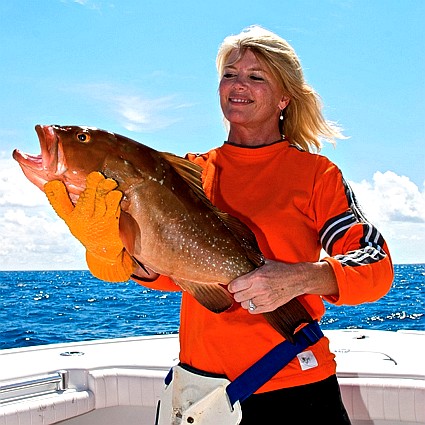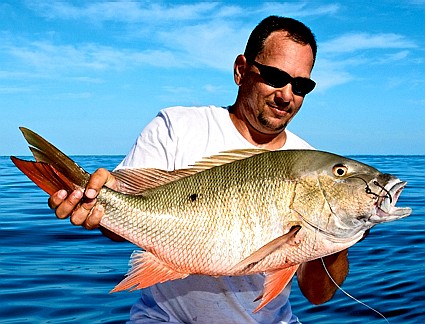March 21, 2012
By Al Herum
Best of all South Florida offshore live baits? We think so.
The snap of taut monofilament popping the outrigger clip turned our heads abruptly toward the water a short distance back from the transom. It's funny how loud that sound can be when you're anchored up in calm seas with no wind. In the split second it took for the slack line to come tight there was nothing but silence. An instant later, we saw a fat slug of white water erupt where a speedo had been swimming lazily in the current just a second before. Quiet was finally broken by a clattering clicker as line dumped off a vintage Penn International reel.
The debate began immediately. One person thought he saw a barracuda slice through the air to the bait, while the captain admonished us all that no cuda was big enough, strong enough, or fast enough to dump that much line that fast against such a heavy drag. It had to be a gi-normous wahoo or kingfish. Either way, the young angler on the rod had his hands full for the next several minutes while he fought the bruiser into sight deep below the boat. It was a kingfish, and a big one at that.
The reason that smoker-size king struck a bait in our chumslick was because we presented it with something it just couldn't resist—a lively speedo. With a beefy yet streamline shape and enticing vibration in the water, a speedo—redtail scad, for name sticklers—is the premier live bait for South Florida anglers seeking an outsized ocean predator. It's the bait of choice for amberjack, smoker kingfish, hefty wahoo and giant grouper. Even sailfish and blackfin tuna will gobble up a speedo if they get a chance.
From Miami through the Florida Keys, you could make a strong case that a speedo will catch more big fish than any other bait. Here's a scenario played out time and time again: Several boats dropping for amberjacks; one begins sending down speedos, the other boats are shut down almost immediately. Once the schooling amberjacks get a taste of a speedo they will literally stop biting on anything else.
Another instance I recall: A father and son catching short grouper after short grouper while patch-reef fishing in the Florida Keys a couple years ago decided to put down the single remaining speedo they'd kept from a trip offshore earlier in the day. They immediately landed a 15-pound black grouper. That fish was obviously sitting under the boat, watching all the catching and commotion, but chose not to bite until it spied that fat speedo on the bottom nearby.
Speedos are big, active baits ranging from about 8 to 14 inches in length. They require some special techniques to catch and keep alive. Let's start with catching.
Scad by the Scads
Schools of speedos can be found along the main reefline in many South Florida areas, including along the whole length of the Florida Keys in water depths ranging from 20 to 150 feet. In shallow water they congregate near certain reefs and ledges; out deeper, look for them over wrecks. They tend to favor areas with clear water and at least a trickle of current. To see if the speedos are in the area, you'll need to chum them in close with frozen block chum.
When they are around they will usually pop up in the chumslick quickly—many times powering in close and eating the chum literally right out of the bag. This is the situation veteran speedo anglers love. When they get in close you can catch 'em easy with either a hoop net and sand balls or on a hook-and-line rig.
For the beginning speedo getter, the hook-and-line rig is the way to go. Rig up a 10- to 15-pound spinning outfit by adding a 3-foot section of 6-pound fluorocarbon leader directly to the main line with a blood knot. Then tie on a super-sharp shortshank No. 6 or 8 hook. If the speedos are right on top you won't need anything else on the line. Bait up with small chunks of fresh ballyhoo, bonito or other tidbits. Make sure the chunk is just big enough to put on the hook as the speedos have a fairly small mouth. Like all bait, speedos can be picky eaters so use only fresh bait and catch as many as you need while they are eating well. Under the best circumstances you'll be able to put your bait right on the surface of the water and hook a speedo immediately, effectively cane-poling them into the boat one at a time (some anglers in fact use long crappie poles, basically fiberglass cane poles, for this purpose).
As you bring each bait in, it is critical that you hold it over the livewell and release it using a curved dehooking tool. You don't want a speedo to fall off and hit the deck—they won't live if they do.
When the speedo school won't come up to your chumbag you'll need to change up your hook-and-line tactics a bit. If you can see the fish hanging back, try dropping a few small chum balls to see if they respond. The balls should be smaller than a golf ball and bigger than a marble, tightly packed, and made from a sand and soft chum mix. If they do react favorably, build the same size ball again, this time covering your hook and bait, and then send it back to them. As it approaches the school, break the chum ball with a quick snap of the rod and you should be on. You may not get it right the first few times but as you practice you'll get it down and should be able to hook one bait on each drift.
If the speedos are really deep or you're only marking them on the bottom machine and not seeing them, use a sabiki rig to catch them. A 12- to 20-pound spinner rigged with a Hayabusa No. 8 in blue and pink mix-yarn or something similar will work for speedos. Use 1/2 to 1 ounce of lead to get down. Start bringing the rig up as soon as you hook the first fish—you only want to catch one speedo at a time or they'll trash your rig. Use your best light-tackle finesse technique to gently ease each speedo to the boat.
Another way to catch speedos is by using a hoop net. These can be purchased or homemade. Most are round with a 4- to 5-foot opening, but homemade versions can get substantially bigger. The technique is to drop the net down into the water as deep as needed and get the speedos to swim over the net; the deeper the bait is hanging the deeper you'll have to drop the net. Unless the school is up high in the water column feeding right out of the chumbag you'll need to use sand balls made from a sand and soft chum mix to get the bait to ball up over the submerged net. Once the hoop net is in position, shake the chumbag a few times, and then drop a couple sand balls so they head right at the net opening. The speedos will swarm in on the dispersing chum and pay little attention to the rising hoop net. It's best to pull the net up slowly, sneaking up on the school. Remove the bait very carefully from the hoop net. If you can't “pour” them right out of the net into a livewell, then it's best to pick them out of the hoop net one at time by hand and place them gently in the bait tank.
 |
Bait Management
Be mindful of how many speedos you put in your baitwell—they're big, they swim fast, and they need a bunch of water to stay lively. Even in a large, round well with good water flow each individual bait will need at least 1.5 to 2 gallons of seawater to stay lively. So if you're using a drum-type well with about 45 gallons of water and pumping capacity large enough to change the water every few minutes, you can safely hold about 30 speedos and keep them alive for the day. If your well is smaller, or square, or has less pump capacity, you'll need to reduce the number of speedos you put in it or they won't live long. Speedos do best in large-diameter, round wells that have a circular flow.
When you're game-planning for smoker kings or giant wahoo, slow-trolling a few speedos or flying a couple from a kite is a proven technique. Slow-trolled baits should be rigged on No. 5 to 7 singlestrand wire with two or three hooks. To make an IGFA legal rig you can start with a razor sharp shortshank 5/0, add about 3 feet of wire in front and a foot behind, then haywire on a second 5/0 as the stinger. Put the lead hook in the speedo's nose and the stinger lightly in the skin between the dorsal and tail. If you don't care about records and want to increase the number of hookups, change out the single hook stinger for a 2/0 4X treble hook. Some anglers even add a second treble hook stinger on really big speedos. Hold the treble in place by putting one point lightly into the skin. You can rig the same way when you fly a speedo from a kite. An alternative hook placement when using the kite is to place the lead hook lightly in the back—halfway between the head and dorsal fin.
Speedos are fast, active, erratic swimmers, so when you're slow-trolling with more than one behind the boat you'll need to keep a close watch to make sure they stay separated. If you move the boat ahead too slowly the speedos will crisscross and create a nightmare tangle. You can avoid this by limiting the number of baits in your spread and moving the boat ahead just fast enough to keep them lined up. Another management trick is to use a pair of scissors to clip off the tips of each bait's tail. Kite-flown and outrigger baits will have plenty of dropback when the clip pops, but flatlines should be clipped off at the transom to add a bit of dropback on the take.
 |
When you're dropping a speedo deep for an amberjack or grouper, rigging is pretty simple. For an amberjack drop, a large circle hook through the speedo's nostrils can't be beat. Most experienced grouper fishermen still prefer a stout J-hook (make sure the J-hooks remain legal in your area). If you're in an area where you can expect a bite as soon as your bait hits bottom, you should hook the speedo through both lips. This yields a secure connection to the bait. If you're not sure how fast you'll get hit, use the nostril area to hook the bait so it will stay lively longer.
Take the time to catch these big, active baits and you'll be a believer once you see how they produce. You'll catch some of your biggest fish on a speedo, guaranteed.
FS

